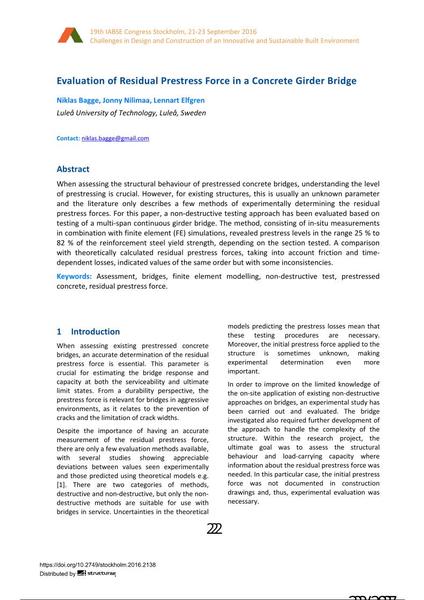Evaluation of Residual Prestress Force in a Concrete Girder Bridge

|
|
|||||||||||
Bibliografische Angaben
| Autor(en): |
Niklas Bagge
Jonny Nilimaa (Luleå University of Technology, Luleå, Sweden) Lennart Elfgren |
||||
|---|---|---|---|---|---|
| Medium: | Tagungsbeitrag | ||||
| Sprache(n): | Englisch | ||||
| Tagung: | IABSE Congress: Challenges in Design and Construction of an Innovative and Sustainable Built Environment, Stockholm, Sweden, 21-23 September 2016 | ||||
| Veröffentlicht in: | IABSE Congress Stockholm, 2016 | ||||
|
|||||
| Seite(n): | 222-229 | ||||
| Anzahl der Seiten (im PDF): | 8 | ||||
| Jahr: | 2016 | ||||
| DOI: | 10.2749/stockholm.2016.2138 | ||||
| Abstrakt: |
When assessing the structural behaviour of prestressed concrete bridges, understanding the level of prestressing is crucial. However, for existing structures, this is usually an unknown parameter and the literature only describes a few methods of experimentally determining the residual prestress forces. For this paper, a non-destructive testing approach has been evaluated based on testing of a multi-span continuous girder bridge. The method, consisting of in-situ measurements in combination with finite element (FE) simulations, revealed prestress levels in the range 25 % to 82 % of the reinforcement steel yield strength, depending on the section tested. A comparison with theoretically calculated residual prestress forces, taking into account friction and time- dependent losses, indicated values of the same order but with some inconsistencies. |
||||
| Stichwörter: |
Brücken Finite-Elemente-Modellierung Bewertung
|
||||


